Research Processes Help Indigenous Communities Share Their Wisdom

Wise Practices Youth Cohort in Métis Crossing, Alberta, one of 5 research sites.
It’s one thing for researchers to descend upon a community, collect information, and then leave, never to be heard from again. It’s quite the opposite for a research project to fulfill its academic objectives in a highly collaborative process, while providing a profound and long-lasting impact on the subjects under study.
That latter is definitely the case with the Wise Practices in Rural Alberta research project that involved five Indigenous communities in Alberta, a team of professional researchers, and a cohort of Indigenous youth along to learn from the experience. The intention was to deeply involve the communities that have been selected as research sites, encourage them to share information and learn from each other, and compile information through community visits, interviews, and facilitated group sessions. The goal was to investigate what has worked, what hasn’t, and why – and to share, document, and disseminate this information for the benefit of Indigenous communities in Alberta and across Canada.
Joceylne Wasacase-Merasty, Prairie regional manager for the National Centre for First Nations Governance, was one of the researchers on the project. Along with several members of the project’s Youth Cohort – all young people from Alberta Indigenous communities – Wasacase-Merasty visited and documented the wise practices of Métis Crossing, one of the five research sites.
One of the tools used to engage with Métis Crossing and the members of the Metis settlement involved in the success of this organization, was a process called a historical scan, said WasacaseMerasty. “What it is basically is a time line that we’re piecing together with a group of people,” she said. “They all have various bits and pieces to add.”
What often emerges from a historical scan is a story that chronicles not just the successes and good times, but also those times that presented particular difficult challenges, she said.
“What’s always interesting is how people start working together to get out of those low points,” Wasacase-Merasty said. “And to get from those low points to a high point, there’s a lot of collaboration, a lot of commitment, a lot of people working together to come up with solutions.”
This collaborative research process not only benefitted the research project, with documented information that can be broadly shared, but also benefits those telling their stories.
“It’s pretty consistent when you go into any community and you do this exercise, there is often a recurring theme.” she said. “It’s the collaboration, it’s the commitment of the people; if they have a common goal and they’re working together, they can overcome a lot of challenges, and that’s something we have to remind ourselves of – that we have the know-how, we have the capability, we have the drive to do those things successfully.”
Janisha Wildman, one of the 15 members of the Youth Cohort, visited another of the research sites in Alberta, the Alberta Indian Investment Corporation (AIIC), which is overseen by a board representing all First Nations in Alberta with its head office located at the Enoch First Nation near Edmonton.
Impressed with the dedication the AIIC shows toward developing and starting Indigenous businesses, and supporting Indigenous entrepreneurs, Wildman found herself thinking about what this could mean to her and her community of the Stoney Nakoda Sioux and Samson Cree Nations. “The idea of business had crossed my mind a few times, out of curiosity,” Wildman said. “This was a chance to listen to other growing First Nations community businesses, and learn how they have become successful. I’m realizing that most businesses do start out small.”
Brian Calliou, director of Indigenous Leadership and Management at The Banff Centre, said the involvement of youth was very important in the research project, particularly as it will be their successes and leadership that shape the future.
“The youth that are really engaged are amazing,” he said. “They were blogging and writing, making journals of their experiences. It was great to see them excited about learning what wise practices are about, and then taking that back to their communities.”
“Currently there are very few documented best practices of Indigenous community economic development in Canada,” Calliou said, “with most of the best practices case studies coming from research conducted in the U.S. With new knowledge into wise practices from our research, we will be filling a gap in the literature and adding important, practical new knowledge.”